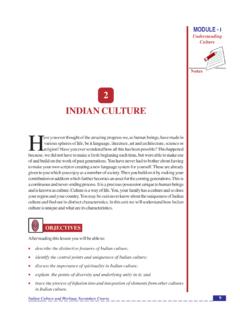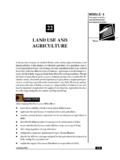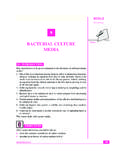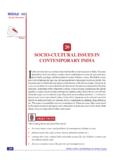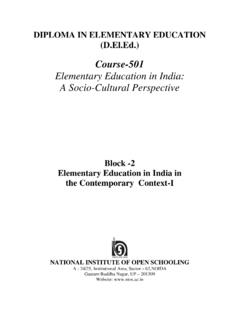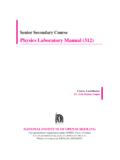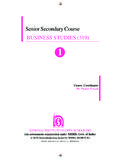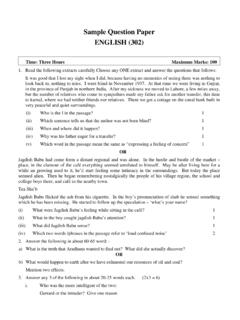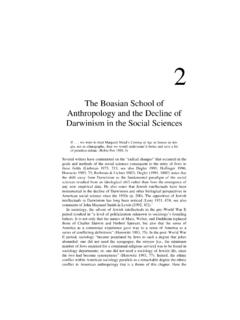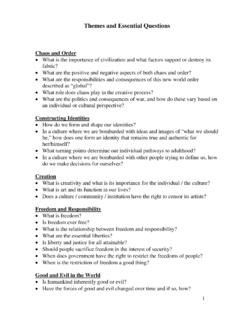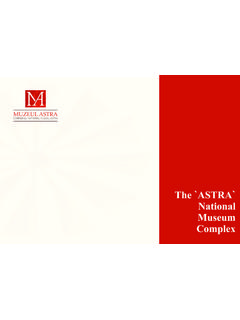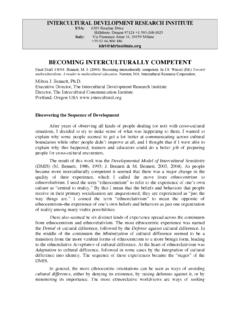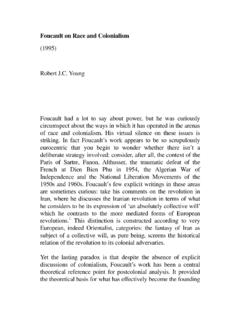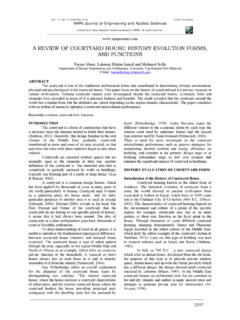Transcription of 1 CULTURE: AN INTRODUCTION T
1 culture : An IntroductionNotes 1 Indian culture and Heritage Secondary CourseMODULE - IUnderstandingCulture1 culture : AN INTRODUCTIONThe English word culture is derived from the Latin term cult or cultus meaningtilling, or cultivating or refining and worship. In sum it means cultivating and refininga thing to such an extent that its end product evokes our admiration and is practically the same as Sanskriti of the Sanskrit language. The term Sanskriti hasbeen derived from the root Kri (to do) of Sanskrit language. Three words came from thisroot Kri; prakriti (basic matter or condition), Sanskriti (refined matter or condition)and vikriti (modified or decayed matter or condition) when prakriti or a raw material isrefined it becomes Sanskriti and when broken or damaged it becomes vikriti . OBJECTIVESA fter studying this lesson you will be able to: understand the concept and meaning of culture ; establish the relationship between culture and civilization ; Establish the link between culture and heritage; discuss the role and impact of culture in human life.
2 CONCEPT OF CULTUREC ulture is a way of life. The food you eat, the clothes you wear, the language you speak inand the God you worship all are aspects of culture . In very simple terms, we can say thatculture is the embodiment of the way in which we think and do things. It is also the thingsCulture: An IntroductionNotesIndian culture and Heritage Secondary Course 2 MODULE - IUnderstandingCulturethat we have inherited as members of society. All the achievements of human beings asmembers of social groups can be called culture . Art, music, literature, architecture, sculpture,philosophy, religion and science can be seen as aspects of culture . However, culture alsoincludes the customs, traditions, festivals, ways of living and one s outlook on variousissues of thus refers to a human-made environment which includes all the material and non-material products of group life that are transmitted from one generation to the next.
3 Thereis a general agreement among social scientists that culture consists of explicit and implicitpatterns of behaviour acquired by human beings. These may be transmitted through symbols,constituting the distinctive achievements of human groups, including their embodiment asartefacts. The essential core of culture thus lies in those finer ideas which are transmittedwithin a group-both historically derived as well as selected with their attached value. Morerecently, culture denotes historically transmitted patterns of meanings embodied in symbols,by means of which people communicate, perpetuate and develop their knowledge aboutand express their attitudes toward is the expression of our nature in our modes of living and thinking. It may be seenin our literature, in religious practices, in recreation and enjoyment. culture has two distinctivecomponents, namely, material and non-material.
4 Material culture consists of objects thatare related to the material aspect of our life such as our dress, food, and household culture refers to ideas, ideals, thoughts and varies from place to place and country to country. Its development is based on thehistorical process operating in a local, regional or national context. For example, we differin our ways of greeting others, our clothing, food habits, social and religious customs andpractices from the West. In other words, the people of any country are characterised bytheir distinctive cultural traditions. INTEXT QUESTIONS How can you say that culture and Sanskriti carry the same meaning?_____2. Fill in the blanks:a. All the achievements of human beings and groups can be culture has two distinctive components viz. material : An IntroductionNotes 3 Indian culture and Heritage Secondary CourseMODULE - IUnderstandingCulture culture AND CIVILIZATIONThe word culture and civilization are often used synonymously.
5 However, they haveclearly defined meanings differentiating them. civilization means having better ways ofliving and sometimes making nature bend to fulfill their needs. It also includes organizingsocieties into politically well-defined groups working collectively for improved conditionsof life in matters of food, dress, communication, and so on. Thus some groups considerthemselves as civilized and look down upon others. This disposition of certain groups haseven led to wars and holocausts, resulting in mass destruction of human the other hand culture refers to the inner being, a refinement of head and heart. Thisincludes arts and sciences, music and dance and various higher pursuits of human lifewhich are also classified as cultural activities. One who may be poor and wearing cheapclothes may be considered uncivilized , but still he or she may be the most cultured possessing ostentatious wealth may be considered as civlilized but he may not becultured Therefore, when we think of culture , we have to understand that it is different from we have seen, culture is the higher levels of inner refinement of a human being.
6 Humansare not merely physical beings. They live and act at three levels: physical, mental andspiritual. While better ways of living socially and politically and better utilization of naturearound us may be termed as civilization . This is not enough to be cultured. Only when thedeeper levels of a person s intellect and consciouness are brought into expression can wecall him/her cultured . INTEXT QUESTIONS What is the difference between culture and civilization ?_____2. Give two similarities of culture and culture AND HERITAGEC ultural development is a historical process. Our ancestors learnt many things from theirpredecessors. With the passage of time they also added to it from their own experienceand gave up those which they did not consider useful. We in turn have learnt many thingsfrom our ancestors. As time goes we continue to add new thoughts, new ideas to thosealready existent and sometimes we give up some which we don t consider useful anyCulture: An IntroductionNotesIndian culture and Heritage Secondary Course 4 MODULE - IUnderstandingCulturemore.
7 This is how culture is transmitted and carried forward from generation to nextgeneration. The culture we inherit from our predecessors is called our cultural heritage exists at various levels. Humanity as a whole has inherited a culture whichmay be called human heritage. A nation also inherits a culture which may be termed asnational cultural heritage includes all those aspects or values of culture transmitted to human beingsby their ancestors from generation to generation. They are cherished, protected andmaintained by them with unbroken continuity and they feel proud of few examples would be helpful in clarifying the concept of heritage. The Taj Mahal,Swami Narayan Temple of Gandhinagar and Delhi, Red Fort of Agra, Delhi s QutubMinar, Mysore Palace, Jain Temple of Dilwara (Rajasthan) Nizamuddin Aulia s Dargah,Golden Temple of Amritsar, Gurudwara Sisganj of Delhi, Sanchi Stupa, Christian Churchin Goa, India Gate etc.
8 , are all important places of our heritage and are to be protected byall the architectural creations, monuments, material artifacts, the intellectualachievements, philosophy, treasures of knowledge, scientific inventions and discoveriesare also the part of heritage. In Indian context the contributions of Baudhayan, Aryabhatta,Bhaskaracharya in the field of Mathematics, Astronomy and Astrology; Kanad andVarahmihir in the field of Physics; Nagarjuna in the field of Chemistry, Susruta and Charakin the field of Medicines and Patanjali in the field of Yoga are profound treasures of IndianCultural heritage. culture is liable to change, but our heritage does not. We individuals,belonging to a culture or a particular group, may acquire or borrow certain cultural traits ofother communities/cultures, but our belongingness to Indian cultural heritage will remainunchanged. Our Indian cultural heritage will bind us together Indian literature andscriptures namely Vedas, Upanishads Gita and Yoga System etc.
9 Have contributed a lot byway of providing right knowledge, right action, behavior and practices as complementaryto the development of civilization . INTEXT QUESTIONS What is cultural heritage?_____2. Give some examples of cultural : An IntroductionNotes 5 Indian culture and Heritage Secondary CourseMODULE - IUnderstandingCulture GENERAL CHARACTERISTICS OF CULTURENow let us discuss some general characteristics, which are common to different culturesthroughout the culture is learned and acquired: culture is acquired in the sense that there arecertain behaviours which are acquired through heredity. Individuals inherit certainqualities from their parents but socio-cultural patterns are not inherited. These arelearnt from family members, from the group and the society in which they live. It is thusapparent that the culture of human beings is influenced by the physical and socialenvironment through which they culture is shared by a group of people: A thought or action may be called cultureif it is shared and believed or practiced by a group of culture is cumulative: Different knowledge embodied in culture can be passedfrom one generation to another generation.
10 More and more knowledge is added in theparticular culture as the time passes by. Each may work out solution to problems in lifethat passes from one generation to another. This cycle remains as the particular culturegoes with culture changes: There is knowledge, thoughts or traditions that are lost as newcultural traits are added. There are possibilities of cultural changes within the particularculture as time culture is dynamic: No culture remains on the permanent state. culture is changingconstantly as new ideas and new techniques are added as time passes modifying orchanging the old ways. This is the characteristics of culture that stems from the culture scumulative culture gives us a range of permissible behaviour patterns: It involves how anactivity should be conducted, how an individual should act culture is diverse: It is a system that has several mutually interdependent these parts are separate, they are interdependent with one another formingculture as culture is ideational: Often it lays down an ideal pattern of behaviour that areexpected to be followed by individuals so as to gain social acceptance from the peoplewith the same culture .
